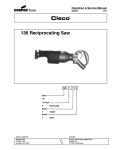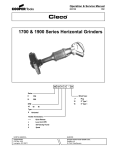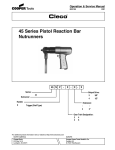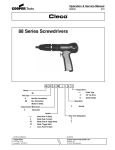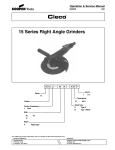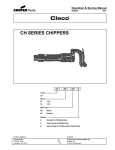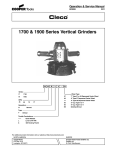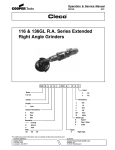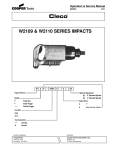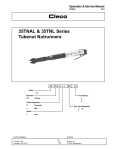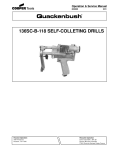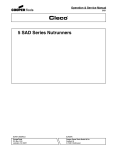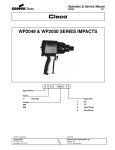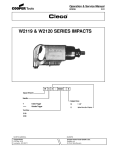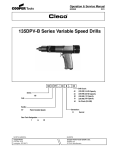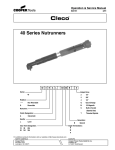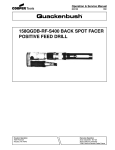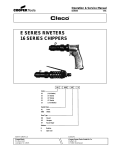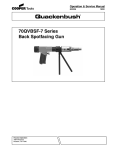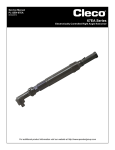Download 136 Bandsaw - Apex Power Tools
Transcript
Operation & Service Manual 823090 2/01 136 Bandsaw 136 B V L Series: 136 Tool Type: B Bandsaw Speed: V Handle: Variable L Inline (Lock-Off Lever) NORTH AMERICA EUROPE CooperTools P.O. Box 1410 Lexington, SC 29071 Cooper Power Tools GmbH & Co. Postfach 30 D-73461 Westhausen 1 Safety Recommendations For your safety and the safety of others, read and understand the safety recommendations before operating this saw. is accidently engaged. Do not use tool to drain residual air from air line. A self-relieving valve is recommended for this purpose. Always wear protective equipment. Work Environment. Work areas should be kept clean and free from clutter. Visitors should be kept away from work area. The air hose should be suspended or placed to prevent damage to the hose or inadvertent tripping to workers. An improperly placed hose can be hooked by a vehicle or worker pulling the saw out of the user’s hands or causing a loss of balance. After use the saw should be disconnected properly and stored. ! CAUTION Personal hearing protection is recommended when operating or working near this tool. Caution: Faceshields do not provide unlimited protection against flying particles and are not to be considered as eye protection. ANSI Z87.1 states that separate eyewear shall be used. For additional information on eye protection, refer to Federal OSHA Regulations, 29 CFR, Section 1910.133, Eye and Face Protection, and ANSI Z87.1, Occupational and Educational Eye and Face Protection. This standard is available from the American National Standards Institute, Inc., 11 West 42nd Street, New York, NY 10036. ! CAUTION Personal hearing protection is recommended when operating or working near this tool. Hearing protection is recommended in high noise areas (above 85 dBA). Close proximity of additional tools, reflective surfaces, process noises, and resonant structures can substantially contribute to the sound level experienced by the operator. Proper hearing conservation measures, including annual audiograms and training in the use and fit of hearing protection devices may be necessary. For additional information on hearing protection, refer to Federal OSHA Regulations, 29 CFR, Section 1910.95, Occupational Noise Exposure, and American National Standards Institute, ANSI S12.6, Hearing Protectors. ! WARNING Wear respirator where necessary. Other protective clothing should be worn as required, unless it creates a greater hazard. Do not wear loose fitting clothing or any jewelry. Gloves can be caught in the the rotating blade causing severe injury. Avoid inhaling dust resulting from the operation of this saw. Wear approved respirator or mask if ventilation is inadequate. Respirators should be selected, fitted, used and maintained in accordance with Occupational Safety and Health Administration and other applicable regulations. This saw is designed to operate on 90 psig (6.2 bar) max. air pressure. Installation of a filter-regulator-lubricator in air supply line is highly recommended. Before tool is connected to air supply, check throttle for proper operation, i.e., throttle moves freely and returns to closed position. Clear air hose of accumulated dust and moisture. Be careful not to endanger adjacent personnel. Before removing tool from service or changing blades, make sure air line is shut off and drained of air. This will prevent tool from operating if throttle 2 ! WARNING Electrical and/or explosive hazard. Be certain that the object being cut does not contain electrical wires or gases. Safe Use. Keep both hands on the saw and away from the cutting area while the blade is rotating. Blades should be kept sharp. Materials to be cut must be securely held to prevent movement. Be aware that end pieces may fall after being cut, and care must be exercised. Never use liquid coolants or cutting oils on the blade or band mechanism. Damage may occur to the blade guides and pulley tires. When cutting conduit or pipe, be certain that live electrical wires and explosive and/or harmful gases or liquids are not present. ! WARNING Repetitive work motions and/or vibration may cause injury to hands and arms. Use minimum hand grip force consistent with proper control and safe operation. Keep body and hands warm and dry. Avoid anything that inhibits blood circulation. Avoid continuous vibration exposure. Keep wrists straight. Avoid repeated bending of wrists and hands. Some individuals may be susceptible to disorders of the hands and arms when performing tasks consisting of highly repetitive motions and/or exposure to extended vibration. Cumulative trauma disorders such as carpal tunnel syndrome and tendonitis may be caused or aggravated by repetitious, forceful exertions of the hands and arms. Vibration may contribute to a condition called Raynaud’s Syndrome. These disorders develop gradually over periods of weeks, months, and years. It is presently unknown to what extent exposureorders develop gradually over periods of weeks, months, and years. It is presently unknown to what extent exposure to vibrations or repetitive motions may contribute to the disorders. Hereditary factors, vasculatory or circulatory problems, exposure to cold and dampness, diet, smoking and work practices are thought to contribute to the conditions. Tool operators should be aware of the following warning signs and symptoms so that a problem can be addressed before it becomes a debilitating injury. Any user suffering prolonged symptoms of tingling, numbness, blanching of fingers, clumsiness or weakened grip, nocturnal pain in the hand, or any other disorder of the shoulders, arms, wrists, or fingers is advised to consult a physician. If it is determined that the symptoms are job related or aggravated by Safety Recommendations movements and postures dictated by the job design, it may be necessary for the employer to take steps to prevent further occurrences. These steps might include, but are not limited to, repositioning the workpiece or redesigning the workstation, reassigning workers to other jobs, rotating jobs, changing work pace, and/or changing the type of tool used so as to minimize stress on the operator. Some tasks may require more than one type of tool to obtain the optimum operator/tool/task relationship. • Tasks should be performed in such a manner that the wrists are maintained in a neutral posi tion, which is not flexed, hyperextended, or turned side to side • Stressful postures should be avoided — select a tool appropriate for the job and work lo cation The following suggestions will help reduce or moderate the effects of repetitive work motions and/or extended vibration exposure: • Use a minimum hand grip force consistent with proper control and safe operation • Avoid highly repetitive movements of hands and wrists, and continuous vibration exposure (after each period of operation, exercise to increase blood circulation) • Keep tool well maintained and replace worn parts (a preventative maintanance program with scheduled inspections is highly recommended) 204203 204203 ! WARNING Electrical and/or explosive hazard. Be certain that the object being cut does not contain electrical wires or gases. OVER Repetitive work motions and/or vibration can cause injury to hands and arms. Use minimum hand grip force consistent with proper control and safe operation. Keep body and hands warm and dry. Avoid anything that inhibits blood circulation. Avoid continuous vibration exposure. Keep wrists straight. Avoid repeated bending of wrists and hands. SAFETY INSTRUCTIONS 1. Use eye and hearing protection. 2. Keep hands away from cutting area. 3. Turn off air when not in use, when changing or adjusting blades, or servicing. 4. Secure work. Use clamps or vise to hold work. 5. Stay clear of end pieces that may fall after being cut off. 6. Keep blades sharp. CAUTION Ulnar Deviation WARNING Neutral ! Avoid WARNING Radial Deviation OK ! Flexion Avoid ! Neutral Avoid Personal hearing protection is recommended when operating or working near this tool. OK This information is a compilation of general safety practices obtained from various sources available at the date of production. However, our company does not represent that every acceptable safety practice is offered herein, or that abnormal or unusual circumstances may not warrant or require additional procedures. Your work may require additional specific safety procedures. Follow these procedures as required by your company. For more information, see the latest edition of ANSI B186.1, Safety Code for Portable Air Tools available from the American National Standards Institute, Inc., 11 West 42nd Street, New York, NY 10036. Impact resistant eye protection must be worn while operating or working near this tool. Avoid anything that inhibits blood circulation — Smoking Tobacco (another contribut ing factor) — Cold Temperatures — Certain Drugs Hearing protection is recommended in high noise areas (above 85 dBA). Close proximity of other tools, reflective surfaces, process noises, and resonant structures can substantially contribute to the sound level experienced by the user. • Read Operating Instructions carefully. Follow the Safety Recommendations for your safety and the safety of others. Extension Keep body and hands warm and dry (cold weather is reported to be a major factor contributing to Raynaud’s Syndrome) Do not remove this tag until the operator of this tool has read these safety precautions. Avoid • 204204 204204 204737 3 READ SAFETY RECOMMENDATIONS BEFORE CONNECTING TOOL. OPERATING INSTRUCTIONS The Cleco bandsaw is designed to operate on 90 psig (6.2 bar) maximum air pressure, using a 5/16" (8mm) x 8' whip hose. If additional length is required, the next larger hose size may be connected to the 8' whip hose. TO START AND STOP SAW Connect air supply. Push the lock-off device foward (A),Fig.1, and depress the throttle lever (B), Fig.1, to start the saw. Releasing throttle lever will stop saw. B A WHICH BLADE TO USE In general, select a blade which will allow at least two teeth to be engaged in the material thickness. The thinner or the harder the material, the finer the blade teeth. The thicker or the softer the material, the coarser the blade teeth. Hi-speed steel blades stay sharp longer than alloy steel blades. Due to the many materials that can be cut, operator's experience will determine which blade will have the longest life for any specific operation. USE OF LUBRICANTS NEVER USE LIQUID COOLANT WITH YOUR BANDSAW. Damage to the blade guide bearings or rubber tires on the pulleys may result. Bandsaw lube wax is available and recommended when cutting aluminum, brass and thick materials. Cast iron should be cut dry. With the saw running, apply the wax momentarily to both sides of the blade. Reapply wax intermittently as needed. ! WARNING EXERCISE EXTREME CARE TO PREVENT HANDS FROM CONTACTING THE BLADE. Fig. 1 LUBRICATION An automatic in-line filter-lubricator is recommended as it increases tool life and keeps the tool in sustained operation. The in-line lubricator should be regularly checked and filled with a good grade of 10W machine oil. Proper adjustment of the in-line lubricator is performed by placing a sheet of paper next to the exhaust ports and holding the throttle open approximately 30 seconds. The lubricator is properly set when a light stain of oil collects on the paper. Excessive amounts of oil should be avoided. STORAGE In the event that it becomes necessary to store the tool for an extended period of time (overnight, weekend, etc.), it should receive a generous amount of lubrication at that time and again when returned to service. The tool should be stored in a clean and dry environment. After prolonged cutting, the wax will cling to the pulleys of your band saw. This does not affect the operation of the machine. All that is necessary is to disconnect the machine from the air supply and wipe the wax from the pulleys. TO CHANGE SAW BLADES ! WARNING DISCONNECT SAW FROM AIR SUPPLY. TO REMOVE BLADE - Turn handle (A), Fig. 2, clockwise to release tension on the saw blade. Remove the blade, first from the pulleys and then from the blade guide. TYPE OF MATERIALS The Cleco bandsaw is designed to cut various types of material up to 4-3/4" diameter or 4-1/4" x 4-3/4" rectangular shape. SELECTING THE BLADE The Cleco bandsaw requires blades that are .020 thick, 1/2" wide, and 44-7/8" long. NOTE: Blades for stationary band saws are of different thickness than above and WILL NOT fit the precision blade guides on portable band saws. Therefore, they MUST NOT be used. 4 A Fig 2. Before installing a blade, clean chips and wax, which may have accumulated on blade guides and pulley tires. 6. Repeat Steps 1 through 5 as necessary to achieve proper tracking. TO INSTALL BLADE - install blade in blade guides and then position on pulleys. MAKE SURE TEETH ON LEFT SIDE OF MACHINE POINT TOWARD THE REAR OF THE MACHINE. See Fig. 3. DIRECTION OF BLADE TRAVEL ON LEFT SIDE OF MACHINE POSITION OF TEETH ON LEFT SIDE OF MACHINE Fig. 3 A Turn handle (A), Fig. 2, counterclockwise as far as it will go. This reinstates tension on saw blade. Start and stop saw two or three times to seat blade on pulleys. TO ADJUST BLADE TRACKING This Bandsaw is equipped with an adjustable Blade Tracking Mechanism. When properly adjusted, the back edge of the blade will run lightly against at least one of the back-up rollers, but will not press heavily against the roller. If the blade fails to track correctly, adjust as follows: Fig. 5 HOW TO USE A PORTABLE BANDSAW 1. Verify material to be cut is firmly held to prevent movement. 2. Hold the saw as shown in Fig. 5, with the work stop (A) contacting the work and blade teeth clear of the work. 1. ! WARNING DISCONNECT SAW FROM POWER SOURCE. 2. Use a 9/|6" wrench to loosen the adjustment locking nut (see Fig. 4), by turning it counterclockwise, one or two turns. 3. Turn saw "ON" and lower onto work. Allow weight of saw to control cutting pressure. Additional pressure will slow down speed of the blade and reduce cutting efficiency. 4. Hold saw straight in the cut. Any twisting or cocking of the blade results in shorter blade life. ! TRACKING SCREW CAUTION 5. Stay clear of end pieces that may fall after being cut off. 6. At completion of cut DO NOT allow saw to fall against work. HOLD SAW SECURELY. 7. Fig. 6 shows the proper cutting position for various shapes. LOCKING NUT Fig. 4 3. Use a flat screwdriver to turn the tracking screw 1/4 turn. Turning the screw clockwise will move the blade further up, toward the blade guide rollers. Turning the screw counterclockwise will move the blade down, away from the blade guide rollers. RIGHT WAY WRONG WAY RIGHT WAY WRONG WAY RIGHT WAY WRONG WAY 4. Tighten the adjustment Iocking nut. 5. Following the directions in TO START AND STOP SAW, operate the saw and observe blade tracking. Fig. 6 5 MAINTENANCE Periodically blow out all air passages with dry compressed air. Remove wax and chip buildup from pulley tires and blade guides. All plastic parts should be cleaned with a soft damp cloth. NEVER use solvents to clean plastic parts. They could possibly dissolve or otherwise damage the material. SERVICE AND REPAIRS All quality tools will eventually require servicing or replacement of parts due to wear from normal use. Repairs should be made by trained staff familiar with this product or by an authorized Cleco Service Center. Original factory replacement parts are recommended to maintain factory performance specifications. If you have any questions about this product, please contact your Cleco distributor or salesman. DISASSEMBLY BACKHEAD The backhead 204212, can be separated from the handle adapter 204206, by removing the retainer pin 204327. To gain access to this pin, carefully roll the grip sleeve 204213, back over itself beginning at the end adjacent to the handle adapter, and until the pin becomes visible. Note: If "O"-rings 844311 and 847272 (2) two, are replaced, do not lubricate. For inspection or replacement of the throttle valve or related parts, unscrew the inlet bushing 204220. The air inlet screen 863598, should be washed in a solvent and blown out in the reverse of normal air flow. Replace the screen if clogged or torn. HANDLE ADAPTER & UPPER HOUSING The handle adapter and upper housing 204210 should not be disassembled unless necessary. To disassemble handle adapter from upper housing remove (3) three hex cap screws 624820 and pull apart. To remove upper housing from lower housing, remove (7) seven hex cap screws 204198 and pull apart. 6 LOWER HOUSING & INTERMEDIATE PLATE To disassemble the lower housing 204211 from the intermediate plate 201655, remove (4) four hex cap screws 845758 and lift complete unit off the intermediate plate. The secondary muffler can be removed for inspection and motor can be pulled out of lower housing. The primary muffler 204214 inside the lower housing can be removed from inside for inspection. MOTOR Use a suitable driver to drive the front rotor shaft out of the front rotor bearing. After removing the cylinder and rotor blades, the rear rotor shaft may be driven out of the rear rotor bearing. REASSEMBLY The tool is reassembled in the reverse order of disassembly. Wash all parts in a solvent and inspect for damage or wear. It is recommended that new rotor blades be installed at each repair cycle. If not replaced, the used ones must measure a minimum of 3/16" (4.7mm) at both ends. Replace if 3/16" (4.7mm) or less at either end. Replace bearings that are rough or have excessive end play. Install the front rotor bearing in the front bearing plate and measure the distance from the face of the bearing plate to the inner race of the bearing with the bearing race loaded rearward. Select or fit by sanding, a rotor collar .001" (.025mm) to .002" (.050mm) longer than this measurement. Install the rotor blades, cylinder rear bearing plate, and rear bearing on the rotor. After final assembly of the motor unit, the cylinder should be held securely but not tightly between the two plates. The rotor should not rub either plate. Tighten all joints securely during reassembly. Place a few drops of 10W machine oil in the air inlet to ensure positive lubrication of all motor parts as soon as air is applied. 7 GEAR AND PULLEY HOUSING PARTS LIST Ref. No. Part No. 7 8* 203096 201652 9* 10 11 11A 12 13 14 15 16 17 18 19 20 21 22 23 23* 201649 204224 204229 204230 204231 204232 204233 204234 204235 204236 204279 204237 204238 204239 204240 204241 201653 24 25 26 27 32 36* 204242 204243 204244 204245 204246 201654 Name of Part Muffler Pulley Housing Assembly, T2, Incl. 74, 75,76,83,84 Knob Set Screw Tension Lever Tension Shaft Yoke Pulley Tire Bushing Bearing Pulley Shaft Pulley Washer Work Stop Screw Blade Guide Roller Blade Guide Bearing Blade Guide Holder Blade Guide Hardware Package Incl. 20, 21,22,24,25,26,27,52 Pin Washer Blade Guide Bearing Screw Screw Yoke Kit, Incl. 14 * Subassemblies 8 Ref. No. Part No. 37 38 48 49 52 53 54 55 56 57 58 59 60 61 65 66 74 75 76 80 81 83 84 85 204247 204248 204249 204250 204251 204252 204253 204254 204255 204256 204257 204258 204259 204260 204261 201655 204262 204263 204264 204265 204266 204267 204268 204269 204270 204271 204272 204204 204203 86 87 Name of Part Screw Washer Tension Spring Screw Lock Washer Chain Driven Sprocket Screw Lock Washer Screw Washer Washer Bearing Gear & Sprocket Intermediate Gear Intermediate Plate Assembly, Incl.60 Needle Bearing Seal Bearing Pin Washer Nut,T2 Set-Screw, T2 Retaining Ring, T2 14 Tooth Bi-metal blade 18 Tooth Bi-metal blade 24 Tooth Bi-metal blade Warning Label Safety Instruction Label BANDSAW BACKHEAD & HOUSING ASSEMBLIES LOCK-OFF LEVER BACKHEAD SUB-ASSEMBLY 201656-6 LOCK-OFF LEVER SUB-ASSEMBLY 201322-5 202105 203133 869855 845409 204213 203519 204221 847808 204327 844306 204212 204219 844311 203523 203524 204218 203522 844308 864271 204220 863598 203521 624820 847272 842305 204206 844309 844312 204214 204215 204211 204210 619164 204217 TO INTERMEDIATE PLATE 204198 204216 845758 INSERT MOTOR ASSEMBLY HERE PARTS LIST BANDSAW BACKHEAD & HOUSING ASSEMBLIES Part No. 202105 † 203133 † 203519 203521 203522 203523 203524 204198 * 204206 * 204210 * 204211 * 204212 204213 204214 * 204215 * 204216 * 204217 * 204218 204219 Name of Part LOCK-OFF PAWL LOCK-OFF LEVER EXHAUST DEFLECTOR THROTTLE VALVE SPRING THROTTLE VALVE THROTTLE VALVE SEAT THROTTLE VALVE BUSHING SOCKET CAP SCREW HANDLE ADAPTER UPPER HOUSING LOWER HOUSING BACKHEAD GRIP SLEEVE PRIMARY MUFFLER SECONDARY MUFFLER SPACER WAVY WASHER THROTTLE VALVE SEAL FLOW VALVE 3ty. 1 1 1 1 1 1 1 7 1 1 1 1 1 1 1 1 2 1 1 Part No. 204220 204221 204327 619164 * 624820 842305 844306 844308 844309 844311 844312 845409† 845758 * 847272 847808 863598 864271 869855 † 869856 † Name of Part INLET BUSHING THROTTLE PIN RETAINER PIN O- RING CAP SCREW WASHER, LOCK O- RING O- RING O- RING O- RING O- RING LOCK-OFF LEVER SPRING PIN ALLEN CAP SCREW O-RING LOCK-OFF LEVER PIN INLET SCREEN SNAP RING LOCK-OFF LEVER SPRING LOCK-OFF LEVER SPRING PIN Qty. 1 1 1 1 3 3 1 1 1 1 1 1 4 2 1 1 1 1 1 The complete Backhead can be purchased as a subassembly using part number: 201656. *Not included in Backhead subassembly. The complete Lock-off lever can be purchased as a subassembly using part number: 201322. †Included in Lock-off lever subassembly. 9 BANDSAW MOTOR 204223 869449 847528 812165 204312 869448 204222 ROTOR COLLAR PART NO. SIZE 864489 847525 864493 865417 .122" .124" .126" .128" PARTS LIST BANDSAW MOTOR * ONLY ONE ROTOR COLLAR REQUIRED. 10 Part No. 204222 204223 204312 812165 847525 847528 864489 864493 865417 869445 869448 869449 Name of Part REAR BEARING PLATE ROTOR CYLINDER (INCLS. 812165) CYLINDER PIN Rotor Collar .124" Front Rotor Bearing Rotor Collar .122" Rotor Collar .126" Rotor Collar .128" REAR BEARING FRONT BEARING PLATE ROTOR BLADE Qty. 1 1 1 1 * 1 * * * 1 1 4 869445 NOTES 11 CooperTools 670 Industrial Drive Lexington, SC 29072 Phone: (803) 359-1200 Fax: (803) 359-2013 www.cooperindustries.com 12












